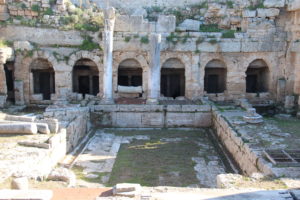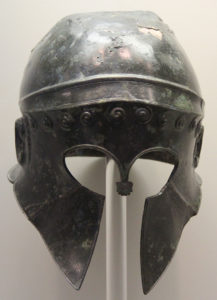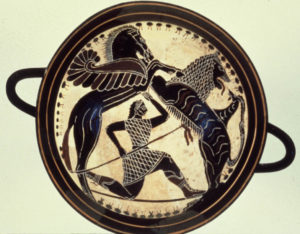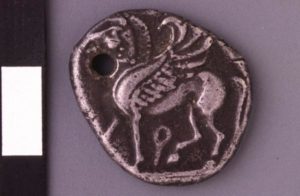
The reputation of a city, whether modern or ancient, is often intertwined with an industry, a landmark, or a hero. For example, Seattle is linked with its major businesses, Microsoft and Boeing. New York’s iconic landmark is Times Square, not to mention the Empire State Building. And Washington, DC, is inextricably linked with George Washington, hero of the Revolutionary War and first President of the United States. When Pausanias reaches the fountain of Peirene on the road to Lechaeum (2.3.2-3), therefore, he has not only reached the center of Roman Corinth, he has also reached the center of his description of the city. It is only fitting then that he calls attention to three prominent features of Corinthian identity: the marvelous properties of Corinthian bronze, the spring Peirene, and the hero Bellerophon and the winged horse Pegasus. The three collectively marked the most notable and continuous icons of Corinth across the Mediterranean, from the archaic period all the way down to the Romans.

The waters of Peirene, according to tradition, are used to temper red-hot bronze. Indeed, bronze working has a long tradition in Corinth that goes back to at least the 7th century BCE. Under the tutelage of the tyrant families Bacchiads and Cypselids, Corinth was well-known for its thriving craft industry, not just for its innovative vase decoration, but also for its bronze working: vessels, plates, figurines, and armor. Although there are no metals available in the Corinthia for smelting bronze, Corinth’s location on the isthmus and its skilled craftspeople lured traders to bring the copper, tin, and lead necessary for making bronze. With the rise of the hoplite phalanx for warfare came the rise of Corinthian helmets as the standard protective gear for hoplites and as votive offerings at Olympia in the mid-7th century. Snodgrass suggests that “’Corinthian’ was almost certainly the name by which the commonest and most protective form of infantry helmet was known in ancient Greece” (108). This close-fitting bronze helmet with only small openings for the eyes and mouth appeared first in the iconography of Corinthian vases before spreading to other regional potters.
Corinth’s reputation for bronze working appears to have only been enhanced during the Roman period. According to the Pliny in his encyclopedic Natural History (34.1, 6-8, 48), Corinthian bronze is sought after by collectors because it is more valuable than silver, and almost more than gold. Additionally, he knows of three types of Corinthian bronze alloys: a white one comparable to silver, one yellowish like gold, and a third a mixture of the two (34.8). Cicero comments that Corinthian bronze is rust resistant (Tusc. Disp. 4.32). Trimalchio, the rich freed slave who is a protagonist of Petronius’ Satyricon, delights in having a collection of Corinthian bronzes (15.31.50). Not surprisingly, the majority (12) of the statues that Pausanias catalogues in the city include bronze ones that adorn the area in or near the agora: in the agora is a Poseidon with a dolphin spouting water, an Apollo Clarius, an Aphrodite by Hermogenes, two Hermes (2.2.8), and a bronze Athena (2.3.1); on the road to Lechaeum are chariots driven by Phaethon and Helios (on the arch), a statue of Heracles, a seated Hermes with a ram standing near him (2.3.2-4); on the road to Sicyon near the fountain of Glauce is another Apollo housed in a temple (2.3.6) and near the gymnasium is a Zeus (2.4.5). Unfortunately, just as so many artworks were removed after Mummius’ sack of Corinth in 146 BCE, none of these bronze images recorded by Pausanias have survived. Instead, scraps found in foundries, two statuettes, and a statue base signed by the sculptor Lysippus are all that remain today of Corinth’s vaunted bronze industry (Mattusch).

By the first half of the seventh century BCE, the hero Bellerophon had become the quintessential Corinthian hero, known best for subduing the Chimaera and bridling the winged horse Pegasus. According to Homer, after being falsely charged with making advances on King Proetus’ wife Anteia, Bellerophon is exiled to Lycia. Unsure how to handle his son-in-law Proetus’ request to kill Bellerophon, the king of Lycia sets a series of tasks for the hero to overcome. Bellerophon first must subdue the Chimaera, a creature “of divine stock, not human, in front a lion, in back a serpent, and in the middle a goat, breathing forth a blast of blazing fire” (Il. 6.180-82). According to Angela Ziskowski, from the Middle to Late Protocorinthian period, ca. 690-630 BCE, the Bellerophon-Chimaera episode appears more frequently than any other narrative scene (five vases). In two of these vases, Bellerophon is riding Pegasus, a bridled winged horse sprung from the head of Medusa.
As important as defeating the Chimaera was, Bellerophon’s other great exploit, bridling Pegasus, became over time even more associated with Corinthian identity. When Bellerophon could not harness the winged horse, Athena appeared to him in a dream, gave him a bridle with cheek pieces, and, always sensitive to Olympian politics, instructed him to sacrifice a bull to his ancestor Poseidon. After he placates Poseidon, the tamer of horses, and dedicates an altar in thanksgiving to Athena, the hero finally succeeds in catching the winged beast and placing the bridle in its mouth. Pindar’s version links this myth to Corinth in at least three ways: the poet dedicates the ode to Xenophon, an Olympic victor from Corinth, recounts Sisyphus and Medea as founders and rulers of Corinth, and allusively places the setting for Bellerophon’s achievement at Peirene (Olympian 13).

Significantly, Corinthian artists are the first and only ones to depict these two myths until the end of the 7th century (Ziskowski 88-95). Once the myth becomes well-known, Corinthian artists are content to represent either one of the mythical creatures as a metonym for the larger narrative. In the sixth century, more than 15 Archaic Corinthian vases depict a Chimaera or a Pegasus. When Corinth began to mint coinage, moreover, it chose to portray Pegasus first as a symbol of the city’s identity. By the end of the sixth century, Corinthian coins paired Pegasus on the obverse with Athena on the reverse, thereby signifying the goddess’ aid for Bellerophon and for the city of Peirene.
Notably, the image of Pegasus continues on Corinthian coinage through the Hellenistic period and is revived when Corinth is refounded as a Roman colony by Julius Caesar. Beginning in 43 BCE, Corinth’s Roman coinage adds a new element to its iconography. Now, instead of just the winged horse, Corinth’s coins begin to show Bellerophon taming Pegasus. And the myth is depicted in numerous paintings and vessels throughout Italy and the Mediterranean.

Before there was a thriving bronze industry or the civic icons Bellerophon and Pegasus, there was the spring that carved a path underground under the Roman forum to the fountain known as Peirene. Geologically, the terrain of Greece is ideally suited for capturing the limited and scattered rainfall that occurs during a typical year. “Limestone strata sandwiched between impermeable layers of marl are often permeable and porous enough to capture and recycle a remarkable amount of water” (Robinson 23). In addition, the slowly eroding limestone around Corinth opened an underground network of channels. With some additional human intervention to increase the waterflow to the fountain, Corinthian rock cutters carved six channels to each of six basins at Peirene. More impressively, two rock-cut supply tunnels more than a kilometer in length—one east of the Forum and one west—direct water to Peirene. It is this ready supply of water seeping through the rock that drew people to settle in Corinth and assured them that they would have fresh water to drink, to cook, to wash, and to use for industry.